#heart valve disease
Text
“You can hear mechanical valves. If they are double, it’s almost like a little clock.”
#medicine#med school#medblr#cardiology#valve replacement#mechanical valves#heart valve disease#bruh one of my friends has a double mech replacement and he says the noise almost drove him crazy at first#also#can confirm they sound like a tiny clock
20 notes
·
View notes
Text
"And then there’s also this sense of amazement. Everyone is so amazed—without even talking too much, as if we had already done it so many times before. Everyone knows his or her part and function. The nurses and the others can read my mind, without any talking. And we are amazed as well at the fluidity and speed that we conduct the operation." 🫀
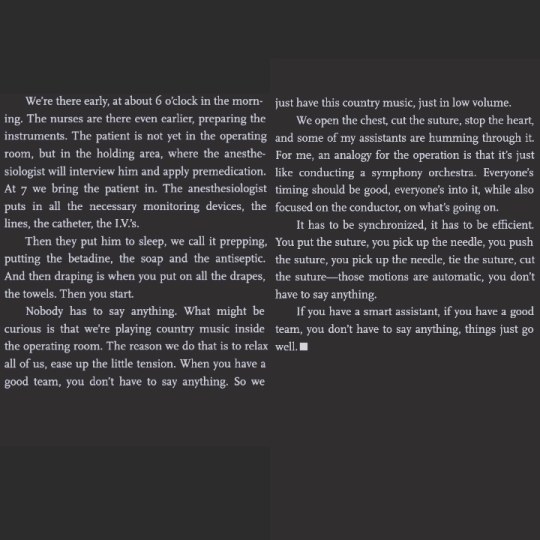
4 notes
·
View notes
Text
Best Cardiologist in Faridabad, Dr. Sanjay Kumar explains the various causes of Heart Attacks in Men & Women.
0 notes
Text
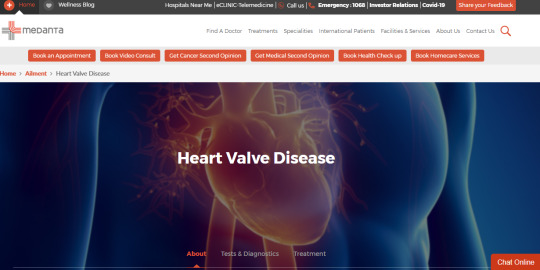
Heart Valve Diseases: Mitral Valve, Tricuspid Valve Causes & Treatment | Medanta
0 notes
Text
The various diseases that need aortic valve surgery are -rheumatic fever, infective endocarditis, aortic valve degeneration, aortic aneurysms, valve tumors. There are 3 main types of aortic valve surgery- open heart surgery, minimally invasive surgery and TAVI. If patient has symptoms like- fatigue, easy tiring, loss of energy, swelling of ankles, then they must get their aortic valve checked. There are many hospitals and surgeons in India where Aortic Valve Surgery is done with great success, like Bangalore, Delhi.

0 notes
Text
If I haven't said it yet:
Upcoming heart surgery (probably) in the near future. Telling just in case I blink off the radar.

2 notes
·
View notes
Text
This is just a poll to make my life seem like a fun game! I don't post anything important and have no followers on this account I know.
#dodgery time#mitral valve disease#hot girls have heart conditions#what the fuckkk#would you rather#heart disease#chronic pain#ed not sheeran#<- NOT USING THAT AS A PRO TAG. PROS KYS IDEC.
3 notes
·
View notes
Text
BIL let the cat out of the house and I think my sister will tie him to a rocket or something.
The cat has severe heart disease.......... :/
#normally i try to defend my BIL bc sometimes my sister's wrath isn't entirely fair#but this time i think he might have killed the cat and that's. uhm. very stupid.#cat has defect heart valves and severe hyperplasia of the heart muscle#and while he's still happy and active under medical supervision it's only a matter of time that his condition will very rapidly decrease#letting him out in firework is uhm... uhm... honestly a left the brain on the shelf in the morning moment#my sister is raging and nearing a nervous breakdown bc she's certain the cat will die tonight#not a good mood#oh god thank goodness we declined their party invitation for today bc this sounds like a nuclear fire i wanna stay away from#sigh#randomness#soryuchan's personal issuss#pet death cw#pet sickness cw#cat is still youngish. i think?? around 10?????? but doesn't have much time left bc the heart disease is progressing#correction: the term is of course hypertrophy but hyperplasia was the closest that came to my mind lol. anyway.#the gist is that the cat has a heart disease and am enlarged struggling heart muscle
6 notes
·
View notes
Text
Embracing the Invisible: Navigating Life with a Chronic Illness
Have you ever faced a challenge that seemed insurmountable? For me, living with a congenital heart condition has been the challenge. I was born with a hole in my heart, underdeveloped arteries, and a missing pulmonary valve. As a child, I was diagnosed with tetralogy of Fallot—a fancy term for my heart condition. My first surgery, a Waterston shunt, took place before I started kindergarten. At…
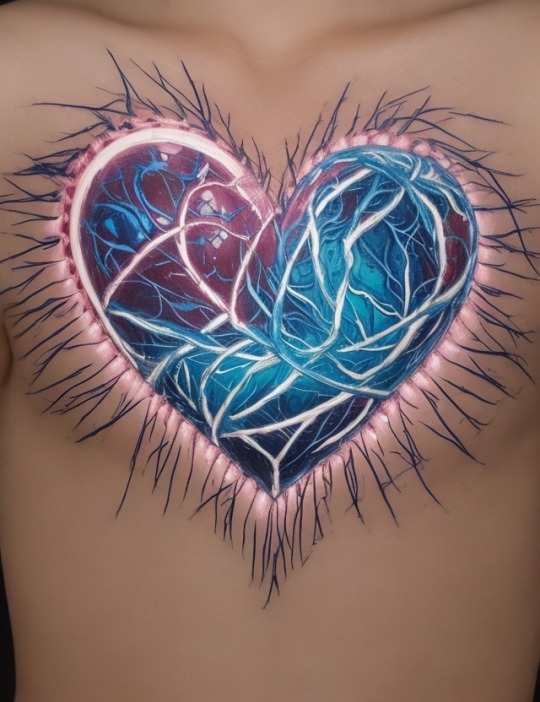
View On WordPress
#Artificial Pulmonary Valve#Blaylock Bypass#Chronic Condition#ChronicIllness#Congenital Heart Disease#CongenitalHeartDisease#Empathy#HealthJourney#Heart Surgery#HeartHealth#HeartStrong#Invisible Illness#InvisibleIllness#OvercomingChallenges#Perseverance#Personal Growth#PersonalGrowth#resilience#Self-Care#SelfDiscovery#Tetralogy of Fallot#Waterston Shunt
0 notes
Text
Brazilian scientists design innovative heart valve
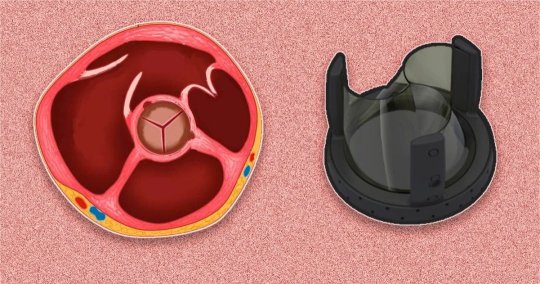
- By Agência FAPESP* -
In Brazil, researchers from the University of São Paulo (USP) and the State University of Campinas (UNICAMP) are trying to perfect the Wheatley aortic valve, a device that could improve the lives of millions of people affected by aortic stenosis, a narrowing of the aortic valve opening that blocks the flow of blood from the left ventricle to the aorta.
Aortic stenosis is common among the elderly, and in severe cases, the only viable alternative to improve the patient's quality of life is to replace the dysfunctional natural valve with an artificial one.
The studies have already won the 2023 USP Post-Doc Award in the field of exact and earth sciences for UNICAMP professor Hugo Luiz Oliveira, a member of the research group.
The improvement of the Wheatley aortic valve is important because it should eliminate the need for anticoagulant medication in the post-operative period, as is the case with other polymer valves.
Anticoagulants are used to “thin” the blood, i.e. they prevent the formation of clots and facilitate blood flow. This type of drug treatment requires extreme patient care and attention, especially when bleeding occurs which can lead to other complications.
The research, developed within the scope of the Center for Mathematical Sciences Applied to Industry (CeMEAI), consists in the computational modeling of the device that replaces the natural aortic valve in patients with severe cases of the disease. CeMEAI is a Research, Innovation and Dissemination Center (RIDC) supported by FAPESP and based at the Institute of Mathematical and Computer Sciences of the University of São Paulo (ICMC-USP), São Carlos campus.
CeMEAI's research focuses on the Wheatley aortic valve, created in 2012 by Scottish professor and cardiac surgeon David Wheatley because the inventor himself felt the need to better understand the mathematical and computer model of the device. The study opportunity for the Brazilian researchers came about when Professor Wheatley contacted Sean McKee of the University of Strathclyde, also in Scotland, UK. McKee, in turn, contacted a former doctoral student under his supervision, USP professor José Alberto Cuminato, coordinator of CeMEAI, who is currently on the faculty at Strathclyde.
Process steps
A high-fidelity computer model not only reduces the time required to design the valve and its internal mechanisms but also the cost of physical prototyping and experimental testing.
The CeMEAI team set out to create a computer model of the Wheatley valve in order to reproduce its mechanical behavior under operating conditions. This allows any improvements that may be made to be tested virtually, without the need to produce new parts for each proposed change.
The experiments aim to ensure that the valve opens and closes quickly and that the shear stress in the blood flow is always above a critical limit. In this way, the system prevents the formation of thromboses and guarantees a longer service life for the device compared to conventional valves.
To achieve the proposed result, the researchers tested several software packages. The option that best met the needs of the research project was the LS-DYNA solver, which allowed the mechanical and fluid dynamic performance of the Wheatley aortic valve to be reproduced on the computer under controlled flow and pressure conditions.
*With information from CeMEAI's Communications Office.
This text was originally published by FAPESP Agency according to Creative Commons license CC-BY-NC-ND. Read the original here.
--
Header image: Models of the Wheatley aortic valve, which the Brazilian researchers were able to model on a computer. Credit: Jornal da USP.
Read Also
The FDA has approved Abbott’s novel dual chamber leadless pacemaker
0 notes
Text
Liquid metal may point the way to wearable ultrasound devices - Technology Org
New Post has been published on https://thedigitalinsider.com/liquid-metal-may-point-the-way-to-wearable-ultrasound-devices-technology-org/
Liquid metal may point the way to wearable ultrasound devices - Technology Org
The best-known byproduct of ultrasound — so named because its frequencies exceed the range of the human ear — is, in fact, not audio but visual: 2D imagery, often of a fetus maturing in the womb. But ultrasound has also found a place in other corners of the medical realm, from assessing blood flow to examining suspicious lumps and diagnosing disease.
A rendering of a stretchable ultrasound device designed by Husker engineers.
That diagnostic capability has recently motivated biomedical engineers to design wearable ultrasound devices that can continuously monitor for signs of trouble, particularly by tracking blood flow or the rhythmic motion of the heart. Ideally, these devices will consist of stretchable material that accommodates movement and the human form.
Unfortunately, a stubborn engineering challenge stands in the way. Ultrasound relies on transducers, which both emit the high-frequency sound waves and detect those reflected back by various structures in the body, ultimately forming an image. Reflections occur wherever the waves cross a boundary between two materials that offer different levels of resistance, or acoustic impedance. To overcome the differing acoustic impedance that waves face in passing from a transducer to the human body — a mismatch that ruins acoustic transmission — engineers install so-called matching layers between the two. Most particles or materials employed as matching layers, though, have proven too rigid for use in pliable, wearable devices.
So what?
Nebraska’s Eric Markvicka, Ethan Krings and colleagues have spent years investigating the properties and potential applications of liquid metal droplets, which include gallium-based alloys. With an eye toward designing a more conforming but still-functional matching layer, the Husker researchers embedded various volumes and sizes of gallium-based droplets in a soft silicone. When saturating the silicone with roughly 70% of the droplets, the team found that the resulting density of the matching layer increased its acoustic impedance by more than 400% — to levels approaching those boasted by more rigid counterparts. And that impedance declined by only 13% when the matching layer was mechanically strained in ways akin to what it might endure as part of a wearable device.
The team then collaborated with Nebraska’s Greg Bashford and Ben Hage to integrate its stretchable matching layer into a wearable ultrasound prototype. When presented with a moving object that simulated the motion of a heart valve or other tissue, the prototype successfully registered that movement, demonstrating its potential as a diagnostic device.
Now what?
Modifying the liquid metal droplets, whether by tailoring their surfaces or their alloys, could further improve the performance of the matching layers that incorporate them, the team said. As the medical field moves toward wearable devices, the researchers said, those matching layers could find their way into specialized ultrasonic sensors that help detect multiple diseases and conditions.
Source: University of Nebraska-Lincoln
You can offer your link to a page which is relevant to the topic of this post.
#alloys#applications#audio#blood#challenge#Design#devices#Disease#Diseases#droplets#ear#employed#engineering#engineers#eye#form#Fundamental physics news#Gallium#heart#heart valve#human#it#Link#liquid#liquid metals#material#materials#medical#metal#monitor
0 notes
Text
Elevate Your Heart Health: Exceptional Cardiovascular Care in Morristown!
Discover top-notch cardiovascular care in Morristown with cutting-edge treatments and compassionate expertise. Whether you're seeking preventative care or specialized treatment, Morristown Cardiology Associates has you covered. Take the first step towards a healthier heart today!
#cardiovascular care group morristown#cardiovascular center morristown#cardiovascular health#cardiovascular wellness#morristown hospital cardiology#morristown heart consultants#best cardiologists in morristown#diagnostic cardiology associates#morris heart associates#morristown cardiologist#hypertension specialist morristown#aortic and mitral valves#high cholesterol treatment morristown nj#cardiovascular disease
0 notes
Text
0 notes
Text
Heart valve surgery is a critical procedure aimed at treating heart valve disease, a condition where one or more of the heart’s four valves malfunction. These valves—tricuspid, mitral, pulmonary, and aortic—play a crucial role in regulating blood flow through the heart chambers. Whether through minimally invasive techniques or open-heart surgery, this procedure involves repairing or replacing damaged valves to restore proper heart function.
#Best Cardiologist in Faridabad#Cardiologist in Faridabad#Heart Doctor in Faridabad#Heart Valve Surgery#heart health#heart disease#best heart specialist in faridabad
0 notes
Text
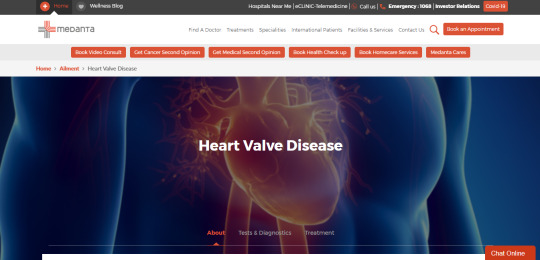
Heart Valve Disease: Symptoms, Treatment & Causes | Medanta
#heart valve disease#heart valve disease symptoms#heart valve disease treatment#heart valve disease causes
0 notes
Text
The various diseases that need aortic valve surgery are -rheumatic fever, infective endocarditis, aortic valve degeneration, aortic aneurysms, valve tumors. There are 3 main types of aortic valve surgery- open heart surgery, minimally invasive surgery and TAVI. If patient has symptoms like- fatigue, easy tiring, loss of energy, swelling of ankles, then they must get their aortic valve checked. There are many hospitals and surgeons in India where Aortic Valve Surgery is done with great success, like Bangalore, Delhi.

#health#dizziness#heart attack#chest pain#heart disease#heart surgery#heart#heart valve disease#aortic valve surgery#tavi
0 notes